Wild Mustard Greens (Vrouves)
The first time I went vrouves-picking with Mama, I confidently assured her that I knew which plants were the mustard plants, and went off into the middle of a good patch. I quickly filled my bag with mustard leaves, and went to show Mama. “What are you doing?” she yelled at me. Then she grabbed my bag from me, and turned it upside down, dumping out the contents. When she calmed down she was able to explain to me that it wasn’t the mustard leaves we wanted, but rather the unopened flower buds. So I took my bag back into the patch and started picking the little green buds. It took a lot longer to fill my bag this time!
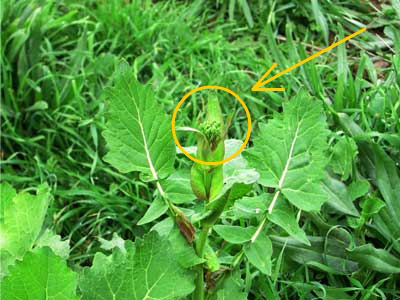
They’re not that easy to spot in the midst of the green leaves! You can see them better below. To pick them put your hand over them and grasp the stem a bit below the bud, then bend it sideways to snap it off. If the bud is really small, the shoot will be mostly leaves, but that’s okay.
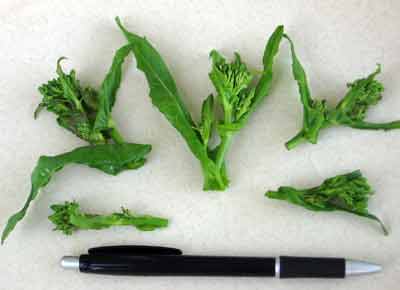
Here’s the field (i.e., vacant lot) where I got the vrouves. It was a blaze of mustard yellow last spring, which is how I found it. People had built houses on my old vrouves field (how dare they?!?) so I was keeping my eyes open for a new one. Unfortunately, by the time I found it, it was too late, and all the flowers were opened. Once opened they’re no good.
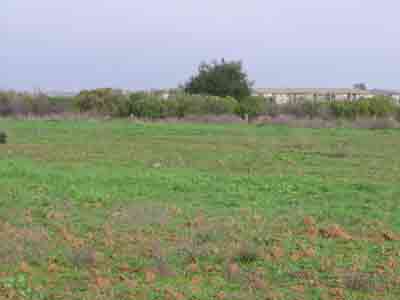
The field is mostly mud right now, but the lush spring growth is well begun. Picking vrouves tends to involve slogging through a lot of mud, because they are at their best within a couple of days of a good rain.
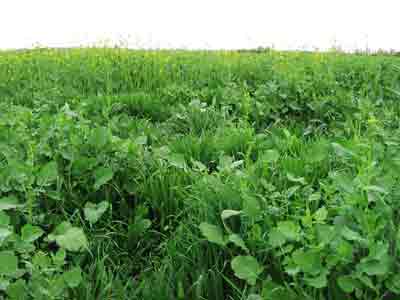
When you have enough, or your back feels like it’s breaking from stooping over, take your greens home and wash them well. Put them in a sink full of water and gently mix them up to help the grit come off. Let them soak for a few minutes, then lift them out of the water (into a large colander, large bowl, or the other sink if you have a double sink) and drain the water. The bottom of the sink will be full of the mud you just wore yourself out slogging through. Rinse the sink and refill it, add the greens and repeat the process. Keep repeating until no more dirt shows up on the bottom of the sink. I usually do one more rinse after this one to make sure, because there’s nothing worse than biting into grit. This is a total of anywhere from three to six sinkfuls of water.
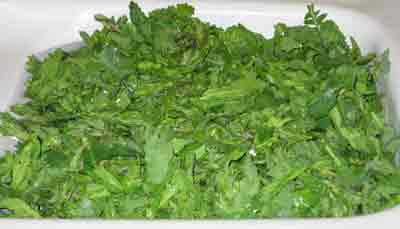
While the vrouves are soaking, put a big pot of salted water on the stove to boil. When the vrouves are clean, start putting them into the boiling water.
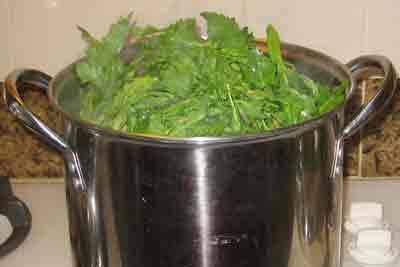
They may not all fit at first, they’ll soon wilt and you’ll be able to push more in.
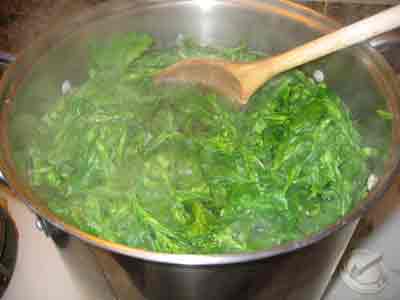
Cook them until they are done to your preference. This batch was done in about 15 minutes after I put them into the water. Drain in a colander (or two).

Dress with lemon juice and olive oil. Add salt to taste. Do not dress any portion that you plan to refrigerate or freeze for later. Yes, these freeze nicely!
Comment by Peter G
Aaah! Good ol’ horta…they never fail to satisfy!
Peter G’s last blog post..Kumatoes
Comment by maria
it was always amusing watching other people watch us collecting horta in new zealand – i knew we looked eccentric collecting greens from a public park, but i couldn’t understand why no one bothered to collect free food!
Comment by FoodJunkie
ARGHHHH, I was just going to post about vrouves! Great one Lulu, i really love them.
FoodJunkie’s last blog post..????????? ??? ?????????? [? ??? ?????????]
Pingback by Chaz’s Lifestream » Blog Archive » Daily Digest for 2009-02-22
[…] Shared a link on Google Reader. Wild Mustard Greens (Vrouves) […]
Comment by Bellini Valli
If only I could recognize them. I wonder if they grow here in our semi-arid climate?
Bellini Valli’s last blog post..Caramel Sea Salt Brownies for Dinner & a Movie
Comment by maria
Are vrouves similar to broccoli rabe / rapini Lulu? Whenever my mother-in-law visits from Greece and I make broccoli rabe / rapini she asks what it is and I always answer vrouves! When in Greece with her, however, we have never found them at the laiki. After reading your lovely post, I now know that it is a green you must really look for and work a bit to enjoy! Thanks!
maria’s last blog post..Tsiknopempti
Comment by Lulu
@1 PeterG: Absolutely!
@2 Maria: One time some people stopped and offered Mama some money so she could buy food. They thought she was gathering horta because she didn’t have enough to eat!
@3 FoodJunkie: I’ll look forward to seeing your vrouves post!
@5 Val: It’s pretty arid where I am in California, so I expect they would.
@6 Maria: Yes, they are similar.
Comment by Paula
These remind me of the bitter greens I used to eat as a kid. They were similar in taste to rabe, but had more of the texture of swiss chard, and we ate them with garlic and olive oil. Your vrouves look lovely, and I imagine every bite tastes spectacular … especially after all the hard work to gather them! YUM!
Paula’s last blog post..Hey! It’s not a bottomless pot of … Smoked Sausage and White Bean Soup!
Comment by James
Wow – never seen those before. Do they taste mustard hot? Reminds me it’s nearly nettle picking time……
Comment by Lulu
@9 Paula – That’s a really good description of them!
@9 James – No, they taste more like broccoli. Actually, I’m not sure how hot they are before being cooked because I’ve never popped a raw bit into my mouth for some reason. Anyway, after being cooked they don’t have any of that mustardy hotness.
Comment by Marc @ NoRecipes
I love foraging for food. Something about it just feels right, kinda like it’s an activity that’s imprinted in our genes. I can’t wait till spring arrives here and I can go to my favourite spot to pick ramps and fiddleheads.
Marc @ NoRecipes’s last blog post..No Recipes vol. 10
Comment by Ivy
Have never eaten vrouves before. I certainly would like to try them if I find them at the farmers’ market.
Ivy’s last blog post..Yemarina Yewotet Dabo (Ethiopian spiced honey bread)
Comment by Nate
Very interesting. I’ve often wondered if there was any use for the wild mustard that grows in the fields around here. They start flowering in January here in Northern California, so the time has already passed to harvest any.
Nate’s last blog post..Our Favorite Layer Cake Recipe
Comment by Lulu
@11 Marc – I agree. You’re lucky you can get ramps and fiddleheads!
@12 Ivy – Definitely try them if you find them. They’re my favorite horta, at least, of the ones I’ve had.
@13 Nate – I also read recently of a guy in LA picking the young leaves of the wild mustard. Can’t remember the name of his blog though.
Comment by costa piperakis
when i was a boyin san francisco,my father would take me to the park and pick salingaria of the bushes(snails)he called them xosloos.he would pour a box of corn starch amoungst them to clarn them out.and he would have them in a stew.what we did not use he would send to his friebds back east.no snail back east.the snails were brought in from europe to satisfy the cravings of the spanish in the 1700s.if the ageraculture inspectors knew what we were doing ,big trouble.but now the park people spry to kill the snails.so… no snail stew anymore.
Comment by costa piperakis
my spelling and typing is terrible
Comment by Lulu
That’s okay, Costa, you have a very interesting story! I would love to try harvesting some snails. I don’t spray for them, so I have plenty.
Comment by Daphni
A friend at church just picked many bags for those interested, as he does every year during Nistia. I’m glad I found some directions to cook them and confirmation and recommendation to concentrate on the flower buds. I was thinking I should only boil the leaves. It looks like the same thing he found in the western part of San Diego. It’s amazing all those tiny spikes cook nicely. The water is boiling right now…
Comment by Lulu
That’s great, Daphni! I’m totally in awe of anybody with the stamina to pick bags to give away. Wow! Yes, these are the same all over the west coast, and elsewhere, I’m sure.
Comment by Leonardo
You obviously know your stuff! Glad I found your blog.
Comment by manju
I’ll have to keep my eyes peeled for these, but I’ll have to take your photos with me so I’ll recognize them. We got lots of funny looks, too, while we were harvesting mugwort leaves in our neighborhood park. Some people just don’t appreciate what’s out there for the harvesting! : )
manju’s last blog post..Roasted Belgian Endive
Comment by Lulu
@21 Manju: I didn’t know you could eat mugwort! (I’m assuming it’s one of the artemisias.) Now you’ve got me curious, have you done any posts where you use it?
Comment by Anonymous
i love hereing stuff like this i use to go ginsinging with my parents when i was a little girl and i stil l love it i love the hills grannyc
Comment by veganyaya
Just found this site. Love the photos, info and all the comments. First time I went to Greece I went ‘horta’ collecting w. the aunts in Andros. When they checked my full bag later, I had one little stem that was good- they had a good laugh.
Comment by Rh
We call them Wild Mustard in the San Joaquin Valley. However, I beg to differ with Mama. The leaves (the tender ones) are indeed edible. We eat them as an Asian Salad. Lightly boiled and drained. Then topped with sliced tomatoes, green onions or red salad onions sliced very thin, and either salted anchovies (sauce) or fish sauce. Yum! Of course, since we’re Asians, it’s great with rice. I have also subbed Wild Mustard for Spinach in pasta dishes and soups. However, it doesn’t like to be cooked twice. It becomes a bit bitter.
Comment by Rh
Oh PS… They sell them at $1.00 a bunch around wintertime here at the Farmer’s Market. Yes, we have one year round farmer’s market every Saturday from 6AM-9AM maybe 10ish if we’re lucky…
Comment by Sailsam
Do wild mustard greens have to be harvested BERFORE the pretty yellow flowers appear?
While in the flowering stage mustard plants are easy to recognize. But before they flower, I’ve looked at the pictures and there’s just a tgreat variety of leaf appearances and many of them are common (to this observer) with many other plants.
Comment by Valleyred
I’ve just returned from my first greek holiday (to kalami on corfu)and can honestly say i was blown away by the food i ate. The most mind blowing of which was Tsigari (containing Horta or whatever wild green is in season) which i had at taverna foros in anno perithia. after my first mouthful i slumped back in my chair and moaned, it was that good. The dish truly tested the time honoured tradition of sharing a plate and passing it on. It’s not a dish i intend on trying to replicate due to the availability of raw ingredients but can only say that feeling will stay with me for a long long time.
VR
Comment by Lolly
I hope people should also be looking for the benefits or the negative impact of everything they eat.
Mustard green is included in the list affecting our thyroid glands.
You can browse it in so many sites, an d here is one: http://www.naturalendocrinesolutions.com/articles/goitrogens-thyroid-inhibiting-foods-you-should-avoid/
Hope this helps.